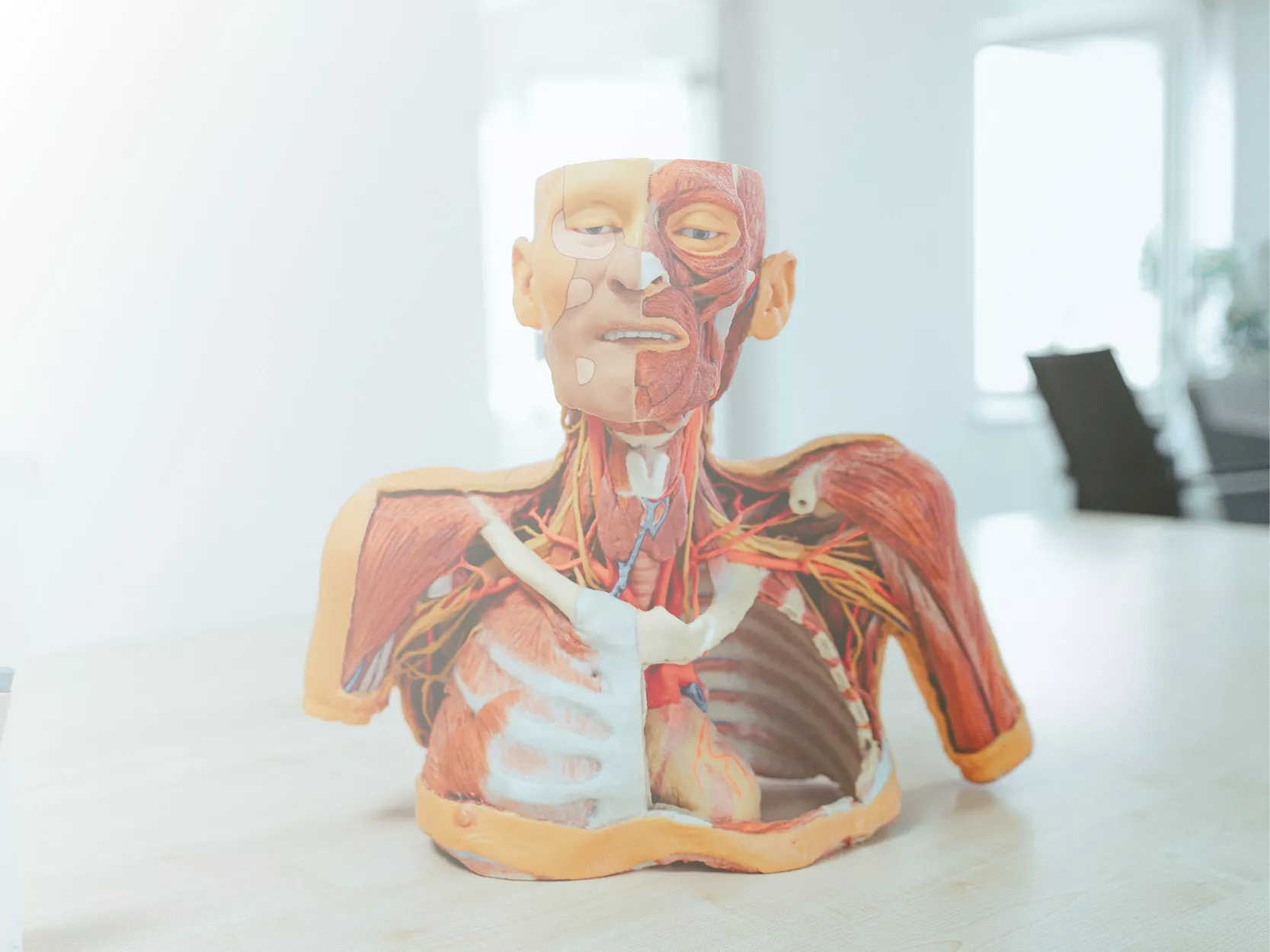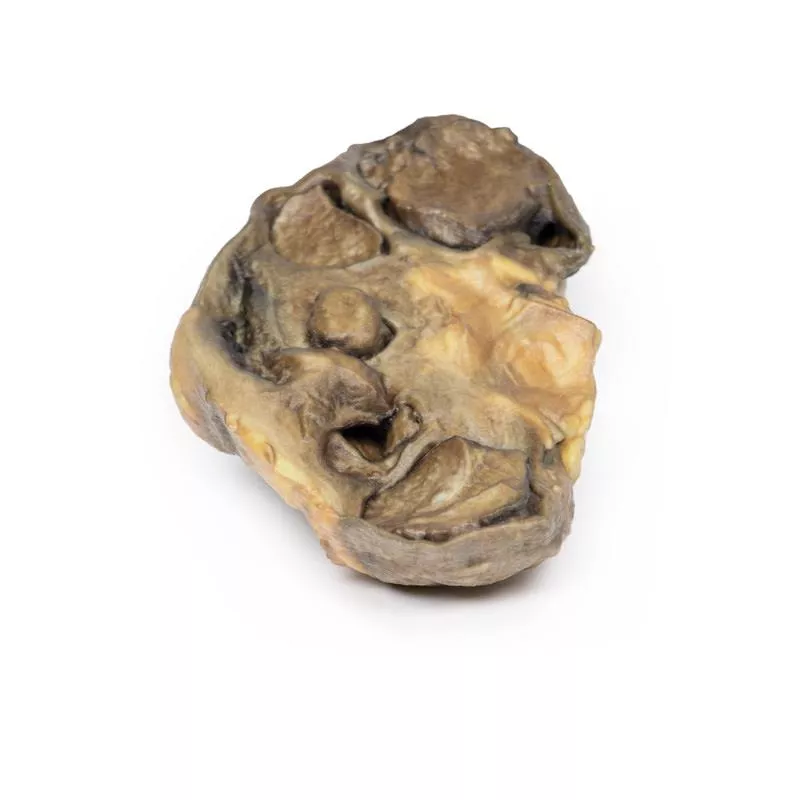Produktinformationen "Septic Renal Infarct"
Klinische Vorgeschichte
Ein 54-jähriger Mann mit aktivem intravenösem Drogenkonsum stellte sich mit Flankenschmerzen, intermittierender Hämaturie, Fieber, allgemeinem Unwohlsein und Erbrechen vor. Bei der Untersuchung fand man Bluthochdruck, Fieber, Janeway-Läsionen und Einstichstellen der Drogennutzung. Ein systolisches Herzgeräusch wurde festgestellt. Die Bluttests zeigten erhöhte Entzündungswerte, eingeschränkte Nierenfunktion, erhöhtes LDH und positive Blutkulturen. Im Echokardiogramm zeigte sich eine große bewegliche Trikuspidalklappenvegetation. Trotz Behandlung der infektiösen Endokarditis verstarb der Patient durch plötzlichen Herzstillstand.
Pathologie
Das Nierenpräparat nach Obduktion zeigt mehrere gut abgegrenzte keilförmige, blass gelb-weiße Infarkte in der Nierenrinde sowie Hämorrhagien. Der größte Infarkt befindet sich am lateralen oberen Pol. Diese Veränderungen entsprechen einem Niereninfarkt.
Weitere Informationen
Niereninfarkt entsteht durch unterbrochene Durchblutung der Niere, die nur eine geringe Kollateralzirkulation besitzt. Die Rinde ist am anfälligsten. Häufige Ursachen sind kardioembolische Ereignisse (z.B. septische Embolien bei Endokarditis), Schäden der Nierenarterie, Gerinnungsstörungen und idiopathische Ursachen. Kardioembolien sind am häufigsten. Etwa 15 % der Infarkte sind beidseitig.
Die Symptome sind unterschiedlich, meist Flankenschmerzen, Hämaturie, Bluthochdruck, Übelkeit, Erbrechen und manchmal Fieber. Urinuntersuchung und Kreatinin-Wert unterstützen die Diagnose. Die kontrastverstärkte CT zeigt typische keilförmige Perfusionsdefekte.
Die Behandlung besteht aus unterstützender Therapie und Behandlung der Grunderkrankung.
Ein 54-jähriger Mann mit aktivem intravenösem Drogenkonsum stellte sich mit Flankenschmerzen, intermittierender Hämaturie, Fieber, allgemeinem Unwohlsein und Erbrechen vor. Bei der Untersuchung fand man Bluthochdruck, Fieber, Janeway-Läsionen und Einstichstellen der Drogennutzung. Ein systolisches Herzgeräusch wurde festgestellt. Die Bluttests zeigten erhöhte Entzündungswerte, eingeschränkte Nierenfunktion, erhöhtes LDH und positive Blutkulturen. Im Echokardiogramm zeigte sich eine große bewegliche Trikuspidalklappenvegetation. Trotz Behandlung der infektiösen Endokarditis verstarb der Patient durch plötzlichen Herzstillstand.
Pathologie
Das Nierenpräparat nach Obduktion zeigt mehrere gut abgegrenzte keilförmige, blass gelb-weiße Infarkte in der Nierenrinde sowie Hämorrhagien. Der größte Infarkt befindet sich am lateralen oberen Pol. Diese Veränderungen entsprechen einem Niereninfarkt.
Weitere Informationen
Niereninfarkt entsteht durch unterbrochene Durchblutung der Niere, die nur eine geringe Kollateralzirkulation besitzt. Die Rinde ist am anfälligsten. Häufige Ursachen sind kardioembolische Ereignisse (z.B. septische Embolien bei Endokarditis), Schäden der Nierenarterie, Gerinnungsstörungen und idiopathische Ursachen. Kardioembolien sind am häufigsten. Etwa 15 % der Infarkte sind beidseitig.
Die Symptome sind unterschiedlich, meist Flankenschmerzen, Hämaturie, Bluthochdruck, Übelkeit, Erbrechen und manchmal Fieber. Urinuntersuchung und Kreatinin-Wert unterstützen die Diagnose. Die kontrastverstärkte CT zeigt typische keilförmige Perfusionsdefekte.
Die Behandlung besteht aus unterstützender Therapie und Behandlung der Grunderkrankung.
Erler-Zimmer
Erler-Zimmer GmbH & Co.KG
Hauptstrasse 27
77886 Lauf
Germany
info@erler-zimmer.de
Achtung! Medizinisches Ausbildungsmaterial, kein Spielzeug. Nicht geeignet für Personen unter 14 Jahren.
Attention! Medical training material, not a toy. Not suitable for persons under 14 years of age.






































